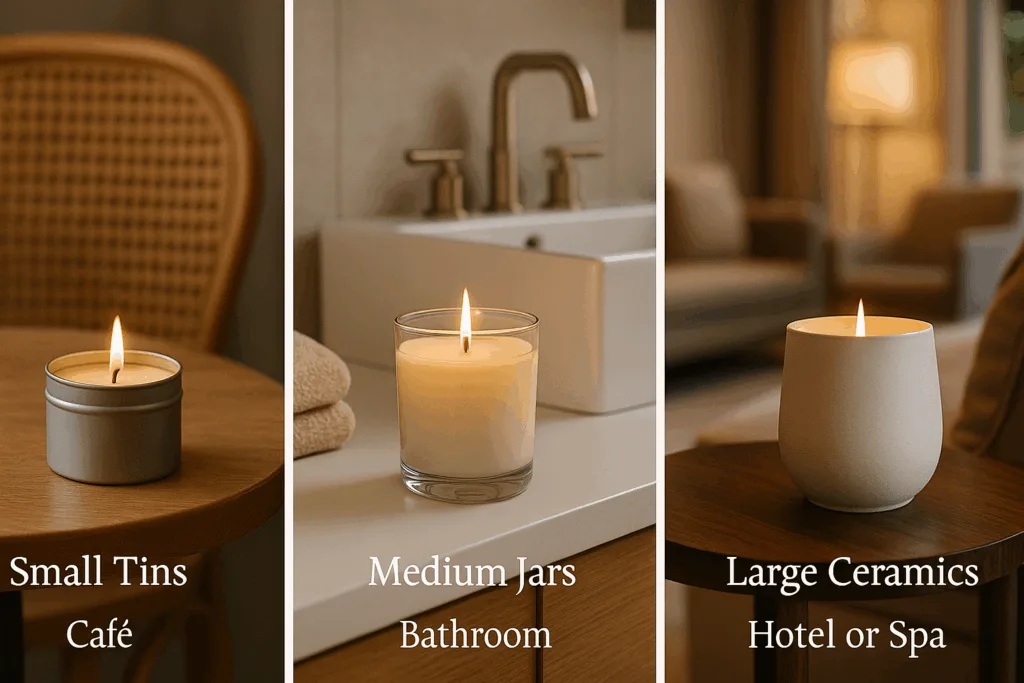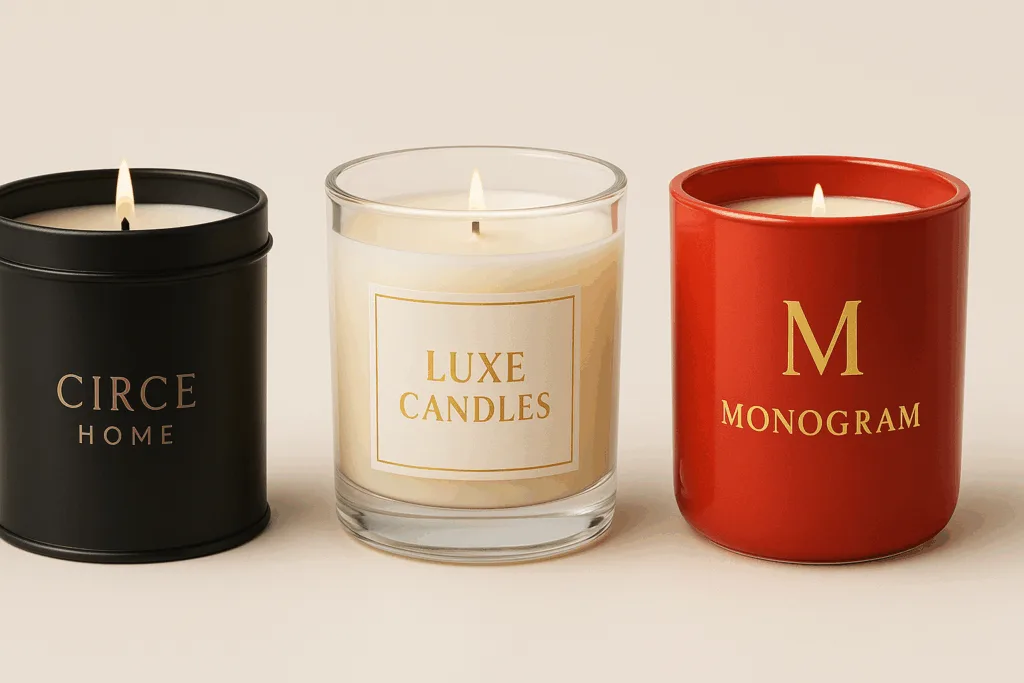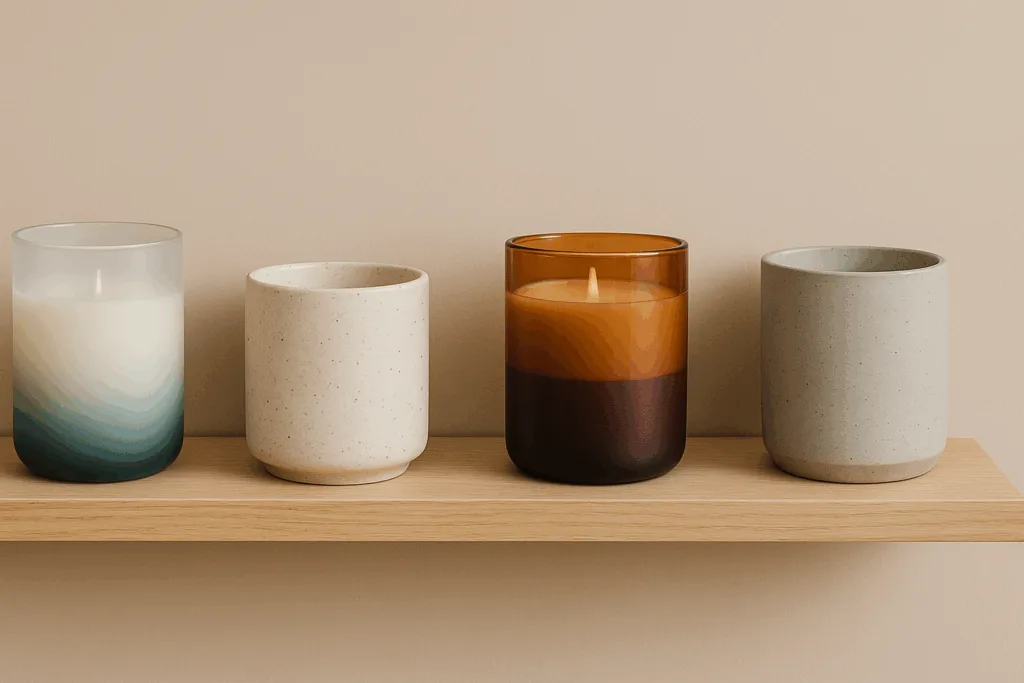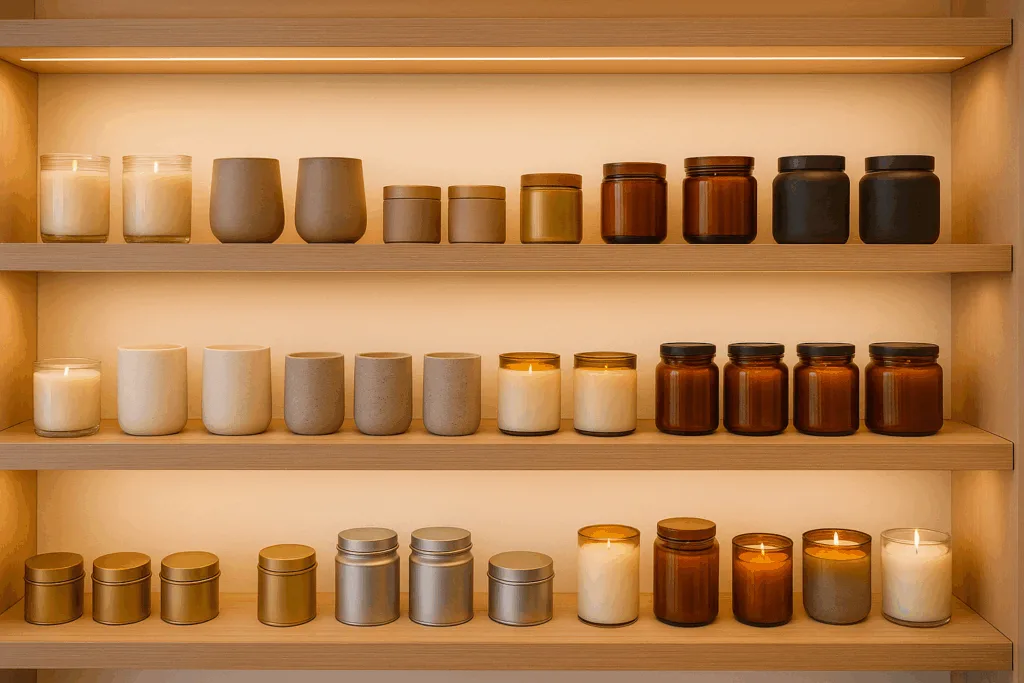1. The Language of Candle Containers in Branding
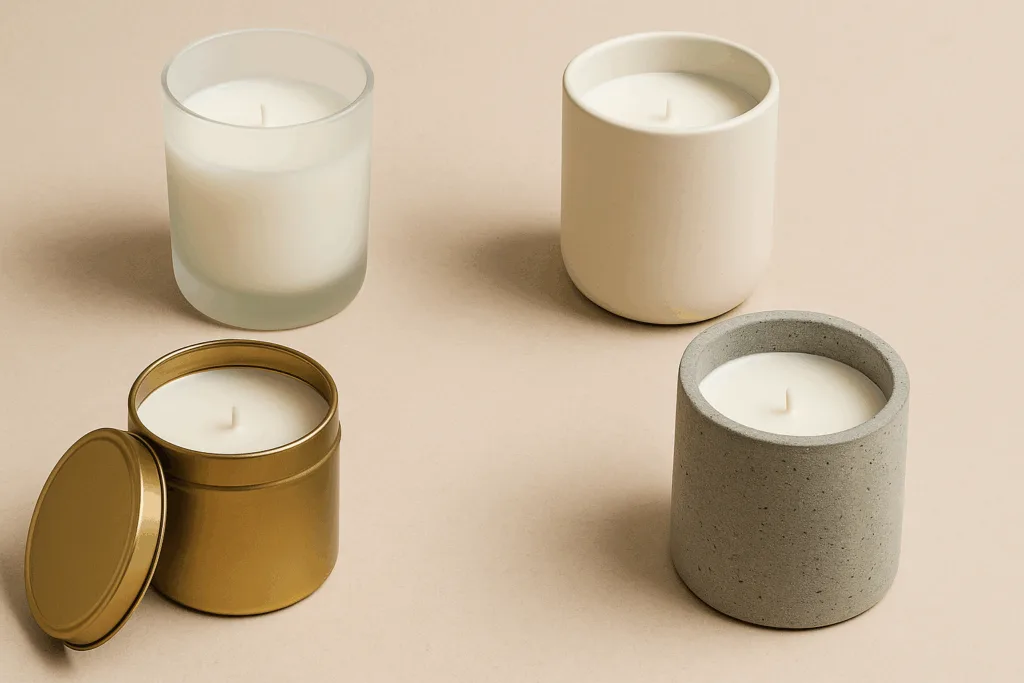
When a customer sees your candle for the first time, the container is often the detail that speaks before the fragrance even reaches them. Candle vessels act as the silent brand ambassadors, communicating luxury, minimalism, eco-consciousness, or creativity. The choice of vessel can be just as important as the candle itself.
- Minimalist brands often choose frosted or matte glass jars, which create a clean, timeless look that appeals to young, modern consumers.
- Luxury brands tend to select ceramic or electroplated metal vessels, which reflect sophistication and exclusivity.
In essence, the vessel is a “first handshake” with your customer. A thoughtfully designed container gives your candle brand a visual identity that lingers long after the flame has burned.
2. Material Choices and Consumer Psychology
The material of a candle container directly influences how consumers perceive your brand:
- Glass: Transparent or frosted glass conveys elegance, purity, and trust. It’s also recyclable, aligning with eco-conscious values.
- Ceramic: Associated with craftsmanship, artisanal quality, and uniqueness. Each piece feels like a collectible.
- Metal & Tins: Durable and travel-friendly. These are often perceived as practical and stylish.
- Concrete: Industrial, edgy, and modern. Perfect for minimalist or design-forward brands.
Today’s consumers are increasingly drawn to sustainable materials. A recyclable glass jar or a biodegradable ceramic container not only holds your candle but also carries an ethical message that resonates with green-minded buyers.
3. Functionality and Safety Considerations
Beyond aesthetics, safety plays a crucial role in container choice:
- Heat resistance: Containers must withstand the high temperatures of burning wax without cracking.
- Thickness: A thicker wall prevents overheating, protecting surfaces and users.
- Durability: Strong vessels survive shipping, handling, and retail display.
Brands should also test containers for stability. A top-heavy vessel may tip over easily, posing fire hazards. Reliable functionality builds trust, ensuring that your candle is as safe as it is beautiful.
4. Candle Container Size & Usage Scenarios
Container size influences both pricing strategy and usage context:
- Small containers (2–4 oz): Ideal for gifts, samplers, or promotional sets.
- Medium containers (6–10 oz): Perfect for everyday home use.
- Large containers (12–20 oz): Best suited for statement pieces in living rooms, hotels, or spas.
For instance:
- A spa might favor large ceramic vessels for a serene, luxurious feel.
- A café may use small tins for branding giveaways.
Matching size to context ensures customers find candles practical and purposeful.
5. Packaging Value and Reusability
Candle vessels are more than wax holders—they’re often part of the gift itself. A stunning container elevates your candle into a premium gift item.
Reusability is another powerful selling point. Consumers love vessels they can repurpose:
- Glass jars become flower vases.
- Tins turn into travel containers.
- Ceramic cups find new life as kitchenware.
By designing containers with upcycling in mind, your brand fosters customer loyalty and sustainability.
6. Market Preferences Across Regions
Regional preferences highlight how culture shapes design:
- North America: Prefers minimalist glass jars and eco-friendly packaging.
- Europe: Appreciates artisanal ceramics and heritage-inspired designs.
- Oceania: Values natural materials like wood and concrete for coastal lifestyles.
Additionally, different customer groups have varying needs:
- Wholesalers seek affordability and uniformity.
- Retailers focus on shelf appeal.
- Importers demand durability for long-distance shipping.
Understanding these nuances allows brands to tailor candle container strategies to specific markets.
7. Customization for Brand Differentiation
Customization elevates candle containers from ordinary to unforgettable. Options include:
- Silk-screen printing of logos.
- Embossed or engraved branding for premium appeal.
- Color finishes like metallics, gradients, or matte coatings.
Circe Home offers low minimum order quantities (MOQ) and flexible customization services, giving small and large businesses alike the ability to stand out. A unique vessel ensures your candle isn’t just another product on the shelf—it becomes a signature.
8. Trends and Innovations in Candle Containers
Staying relevant means keeping up with evolving design trends:
- Frosted gradient glass evokes calm sophistication.
- Handmade ceramic vessels signal craftsmanship.
- Dual-tone glass creates visual intrigue.
- Eco-concrete containers balance modern aesthetics with sustainability.
Innovative vessels can spark curiosity and boost brand visibility. For example, introducing limited-edition seasonal vessels keeps customers excited and engaged.
9. Luxury vs. Minimalist Aesthetic in Candle Vessels
Two dominant design directions are shaping today’s market:
- Luxury Aesthetic: Features metallic coatings, intricate embossing, or thick ceramic bases. These vessels make candles feel like indulgent treasures.
- Minimalist Aesthetic: Relies on clean lines, neutral colors, and matte finishes. This appeals to consumers who prioritize simplicity and modernity.
Both aesthetics have loyal customer bases. The key is aligning your vessel choice with your brand’s core identity.
10. Eco-Friendly and Sustainable Candle Containers
Sustainability is no longer optional—it’s a market expectation. Eco-conscious consumers value:
- Recyclable glass jars
- Plant-based ceramics
- Reusable tins
- Biodegradable packaging
Highlighting eco-friendly features on your product labeling can strengthen brand trust. For example, stating “100% recyclable glass” reassures buyers that they are making a responsible choice.
11. Cost Factors in Choosing Candle Containers
Budget plays a critical role in vessel selection:
- Bulk orders lower per-unit cost.
- Material choice affects pricing (ceramic costs more than tin).
- Customization adds value but may increase costs.
However, higher container costs can be justified if they increase perceived brand value. Consumers are often willing to pay more for a candle that feels premium.
12. The Role of Candle Containers in Retail Experience
In retail environments, vessels act as silent salespeople. A well-designed container can attract attention across the aisle:
- Visual appeal encourages impulse purchases.
- Tactile experience—smooth glass, cool metal, or textured ceramic—enhances customer connection.
- Scent preservation is also crucial; tightly fitting lids keep fragrances fresh.
Retailers value candles that “sell themselves” through design. Investing in quality vessels ensures your product stands out.
13. Cultural Symbolism of Candle Containers
Containers often carry cultural meanings:
- Eastern markets may value symbolism in colors, like red for luck or gold for prosperity.
- Western markets emphasize seasonal themes, such as green and white for Christmas.
Shapes also convey meaning. For example, round containers suggest harmony, while angular designs communicate boldness. Understanding cultural symbolism allows brands to connect on a deeper emotional level.
14. Containers for Special Events and Corporate Gifting
Candle containers play a pivotal role in event marketing and gifting:
- Weddings: Elegant frosted glass or personalized engraving.
- Holiday seasons: Festive tins with seasonal motifs.
- Corporate gifts: Branded ceramic or metal vessels with company logos.
By offering customizable event containers, brands can tap into lucrative markets beyond everyday retail.
15. Case Studies: Successful Brands and Their Candle Containers
Some successful candle brands owe part of their popularity to vessel design:
- Luxury spa brands: Use heavy ceramic jars to reinforce tranquility.
- Lifestyle brands: Embrace tins and travel-friendly vessels.
- Eco brands: Rely on recyclable glass with minimal packaging.
These case studies show that the right container choice can shape customer perception and strengthen brand positioning.
16. DIY Candle Container Selection for Small Businesses
For startups and hobbyists, selecting candle containers can feel overwhelming. Practical tips include:
- Start small with tins or glass jars, which are affordable and versatile.
- Avoid overly complex shapes until you scale.
- Consider second-hand or upcycled containers for eco-friendly appeal.
By keeping choices simple yet stylish, small businesses can grow sustainably without compromising brand image.
17. Future of Candle Containers
The future of candle vessels is being shaped by technology and sustainability:
- Smart vessels: Imagine containers with heat sensors or Bluetooth-enabled lids.
- Sustainable innovation: Plant-based composites, biodegradable resins, or solar-powered lids.
As customer expectations evolve, so will vessel design. Brands that adapt early will remain ahead in the competitive candle market.
Conclusion: Finding the Right Candle Container for Your Brand Identity
Choosing the right candle container is more than a design decision—it’s a brand-defining strategy. From material and size to customization and sustainability, each detail influences customer experience. By aligning vessel design with brand values, candle makers create products that resonate deeply and stand the test of time.
Frequently Asked Questions (FAQ)
1. How long does a candle burn depending on its container size?
Smaller containers (2–4 oz) may last 10–15 hours, while large vessels (12–20 oz) can burn for 50+ hours. Burn time depends on wax type, wick size, and container thickness.
2. What’s the difference between essential oils and fragrance oils in candles?
Essential oils are natural plant extracts, offering therapeutic benefits. Fragrance oils may be synthetic but provide stronger, longer-lasting scents. Both can be safely used in candle containers if tested properly.
3. How do I choose the right fragrance for my candle brand?
Consider your target audience. Calming scents like lavender suit spa brands, while energizing citrus works well for lifestyle or wellness candles.
4. Are candle containers eco-friendly?
Yes—if made with recyclable or reusable materials like glass, tin, or biodegradable ceramics. Many brands highlight eco-friendly packaging as a selling point.
5. Can candle vessels be customized for corporate gifts?
Absolutely. Options include engraved logos, printed labels, and custom colors. This makes them popular for holiday gifting and events.
6. What safety checks should I perform before selling candles?
Ensure containers are heat-resistant, crack-proof, and stable. Always test burn time and container durability under different conditions.

